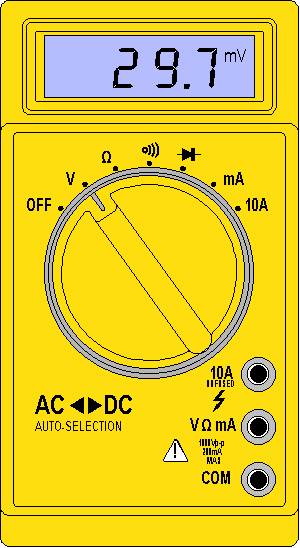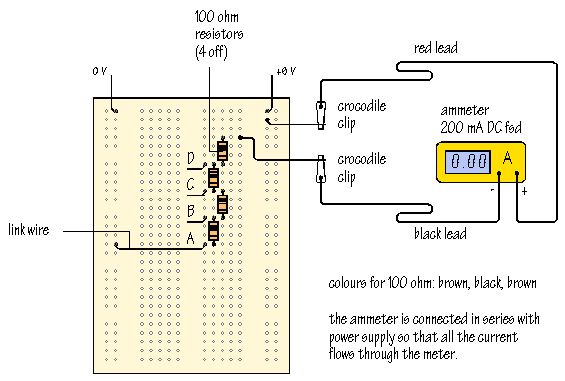|
|
|
A meter is a measuring instrument. An ammeter measures
current, a voltmeter measures the potential difference
(voltage) between two points, and an ohmmeter measures
resistance. A multimeter combines
these functions, and possibly some additional ones as
well, into a single instrument.
Before going in to detail about multimeters, it is
important for you to have a clear idea of how meters are connected into
circuits. Diagrams A and B below show a circuit before and
after connecting an ammeter:
|
A |
|
B |
|
|
to
measure current, the circuit must be broken to allow the |
|||
|
ammeters
must have a LOW resistance |
|||
Think about the changes you would have to make to a practical circuit in
order to include the ammeter. To start with, you need to break the circuit
so that the ammeter can be connected in series. All the current flowing in the
circuit must pass through the ammeter. Meters are not supposed to alter the behaviour of the circuit, or at least not significantly,
and it follows that an ammeter must have a very LOW resistance.
Diagram C shows the same circuit after connecting a voltmeter:
|
A |
|
C |
|
|
to
measure potential difference (voltage), the circuit is not changed: |
|||
|
voltmeters
must have a HIGH resistance |
|||
This time, you do not need to break the circuit. The voltmeter is connected
in parallel between the two points where the measurement is to be made. Since
the voltmeter provides a parallel pathway, it should take as little current as
possible. In other words, a voltmeter should have a very HIGH resistance.
Which measurement technique do you think will be the more useful? In fact,
voltage measurements are used much more often than current measurements.
The processing of electronic signals is usually thought of in voltage terms.
It is an added advantage that a voltage measurement is easier to make. The orginal circuit does not need to be changed. Often, the
meter probes are connected simply by touching them to the points of interest.
An ohmmeter does not function with a circuit connected to a power supply. If
you want to measure the resistance of a particular component, you must take it
out of the circuit altogether and test it separately, as shown in diagram D:
|
A |
|
D |
|
|
to
measure resistance, the component must be removed from the circuit altogether |
|||
|
ohmmeters
work by passing a current through the component being tested |
|||
Ohmmeters work by passing a small current through the
component and measuring the voltage produced. If you try this with the
component connected into a circuit with a power supply, the most likely result
is that the meter will be damaged. Most multimeters
have a fuse to help protect against misuse.
|
|
Multimeters are designed and mass produced for
electronics engineers. Even the simplest and cheapest types may include
features which you are not likely to use. Digital meters give an output in
numbers, usually on a liquid crystal display.
The diagram below shows a switched range multimeter:
 Switched
range multimeter
Switched
range multimeter
The central knob has lots of positions and you must choose which one is
appropriate for the measurement you want to make. If the meter is switched to 20
For circuits with power supplies of up to 20 V, which includes all the
circuits you are likely to build, the 20 ![]() on
the meter. Sometimes, you will want to measure smaller voltages, and in this
case, the 2 V
or 200 mV
ranges are used.
on
the meter. Sometimes, you will want to measure smaller voltages, and in this
case, the 2 V
or 200 mV
ranges are used.
What does DC mean? DC means direct current. In any circuit
which operates from a steady voltage source, such as a battery, current flow is
always in the same direction. Every constructional project descirbed
in Design Electronics works in this
way.
AC means alternating current. In an electric lamp connected
to the domestic mains electricity, current flows first one way, then the other.
That is, the current reverses, or alternates, in direction. With
![]()
For safety reasons, you must NEVER connect a multimeter to the mains supply.
You are not at all likely to use the AC ranges, indicated by
![]() ,
on your multimeter.
,
on your multimeter.
An alternative style of multimeter is the autoranging multimeter:
 Autoranging multimeter
Autoranging multimeter
The central knob has fewer positions and all you need to do is to switch it
to the quantity you want to measure. Once switched to V, the meter automatically adjusts
its range to give a meaningful reading, and the display includes the unit of
measurement, V
or mV. This
type of meter is more expensive, but obviously much easier to use.
Where are the two meter probes connected? The black lead is
always connected into the socket marked COM, short for COMMON. The red lead is connected into the socket labelled V![]() mA.
The 10A
socket is very rarely used.
mA.
The 10A
socket is very rarely used.
An analogue meter moves a needle along a scale. Switched range analogue multimeters are very cheap but are difficult for beginners
to read accurately, especially on resistance scales. The meter movement is
delicate and dropping the meter is likely to damage it!
Each type of meter has its advantages. Used as a voltmeter, a digital meter
is usually better because its resistance is much higher, 1 M![]() or 10 M
or 10 M![]() ,
compared to 200
,
compared to 200 ![]() for
a analogue multimeter on a
similar range. On the other hand, it is easier to follow a slowly changing
voltage by watching the needle on an anlaogue
display.
for
a analogue multimeter on a
similar range. On the other hand, it is easier to follow a slowly changing
voltage by watching the needle on an anlaogue
display.
Used as an ammeter, an analogue multimeter has a
very low resistance and is very sensitive, with scales down to 50 µA. More
expensive digital multimeters can equal or better
this performance.
Most modern multimeters are digital and
traditional analogue types are destined to become obsolete.
1. Voltage measurements:
Build the circuit shown below using prototype board
and four 10 ![]() resistors:
resistors:
Using the multimeter as a voltmeter, measure the
power supply voltage and then measure the voltages at points A, B and C.
What do you notice about your results?
![]()
The four resistors are connected in series, making a chain known as a potential
divider, or voltage divider. The total voltage is
shared between the four resistors and, allowing for tolerance, each resistor
receives an equal share. (You will find out a lot more about potential dividers
in the next Chapter.)
Modify the circuit, replacing one or more of the 10 ![]() resistors
with 1
resistors
with 1 ![]() or
100
or
100 ![]() values.
Are the results as you expect?
values.
Are the results as you expect?
The diagram below shows a light sensor
circuit built in a similar way:
The circuit uses an LDR, or light dedpendent resistor. The resistance of the LDR
changes with illumination. In the dark, the resistance is high, up to 1 M![]() or more. When light shines on the LDR, the light energy increases the number of
charge carriers available to transfer current, and the resistance falls. In
bright light, the resistance can be as little as 100
or more. When light shines on the LDR, the light energy increases the number of
charge carriers available to transfer current, and the resistance falls. In
bright light, the resistance can be as little as 100 ![]() .
.
What happens to the output voltage of the light sensor circuit when you
cover the LDR with you hand?
![]()
Is the output voltage HIGH or LOW in the dark?
![]()
2. Resistance measurements:
Remove the LDR from the circuit and measure its
resistance, as follows:
To get the multimeter to function as an ohmmeter,
you will need to select a resistance range. With a switched range meter, the 200 k position
is usually suitable. You will see the resistance measurement change as the
light level changes. Covering the LDR with your hand increases the resistance
of the LDR.
If the meter reads ![]() this
means that the resistance is more than the maximum which can be measured on
this range and you may need to switch to a new position, 2000 k, to take a
reading. (How many megohms is 2000 k?)
this
means that the resistance is more than the maximum which can be measured on
this range and you may need to switch to a new position, 2000 k, to take a
reading. (How many megohms is 2000 k?)
You can check the value of any fixed value resistor in the same way, and
confirm that you have worked out the colour code
correctly. Don't forget that the colour
code convertor program is available to help you.
3. Current measurements:
The diagram below shows a prototype board set up for
the measurement of current:

Note that the current must flow through the ammeter in order to
reach the circuit.
Take a reading of the current with the link wire to 0 V in position A.
Write down the current value you observe:
![]() A:
A:
Take new readings after moving the link to positions B, C and D:
|
|
B: |
C: |
D: |
Don't forget to write in the measurement units of your answer.
As the resistance is reduced, current increases.
Calculate the current expected in each case using the formula:
|
|
Small variations, up to ±5%, can be attributed to the tolerance of the
resistors.